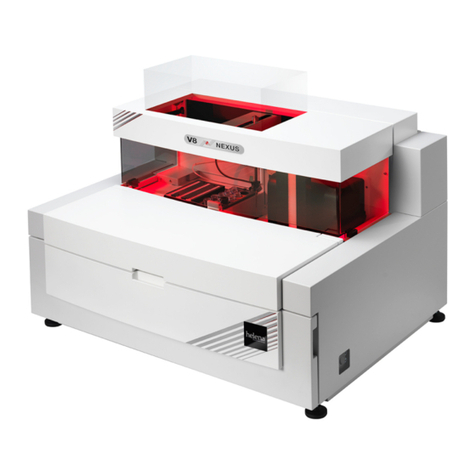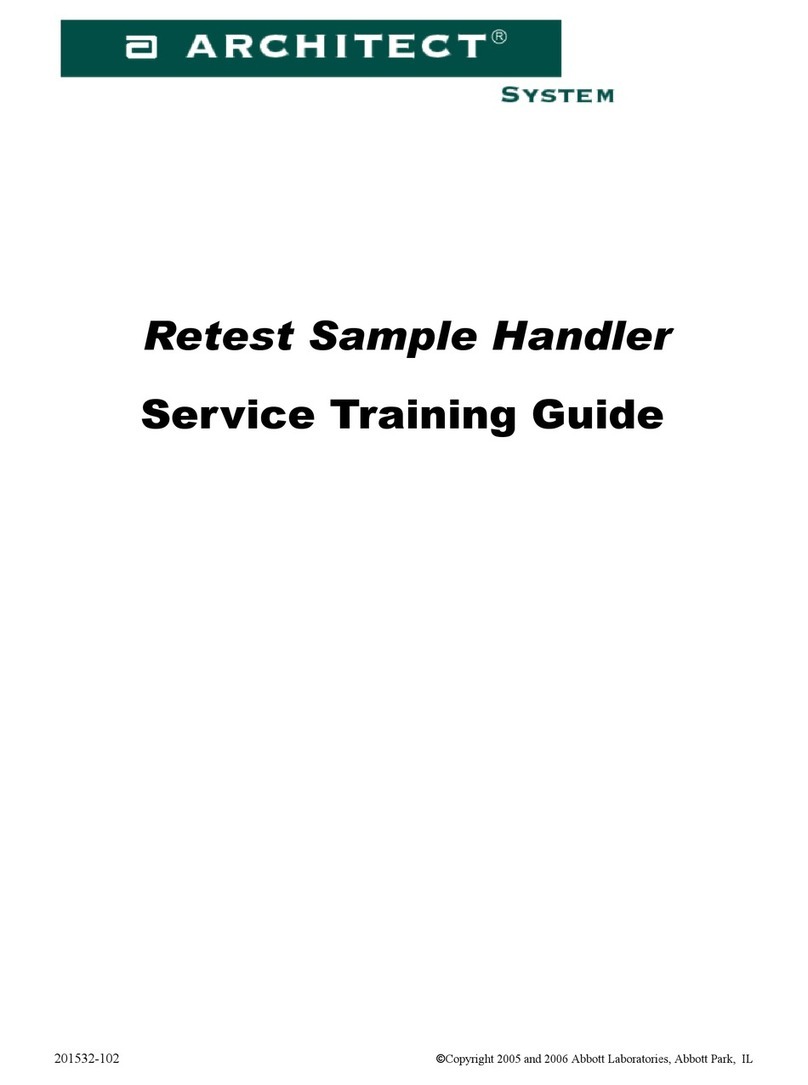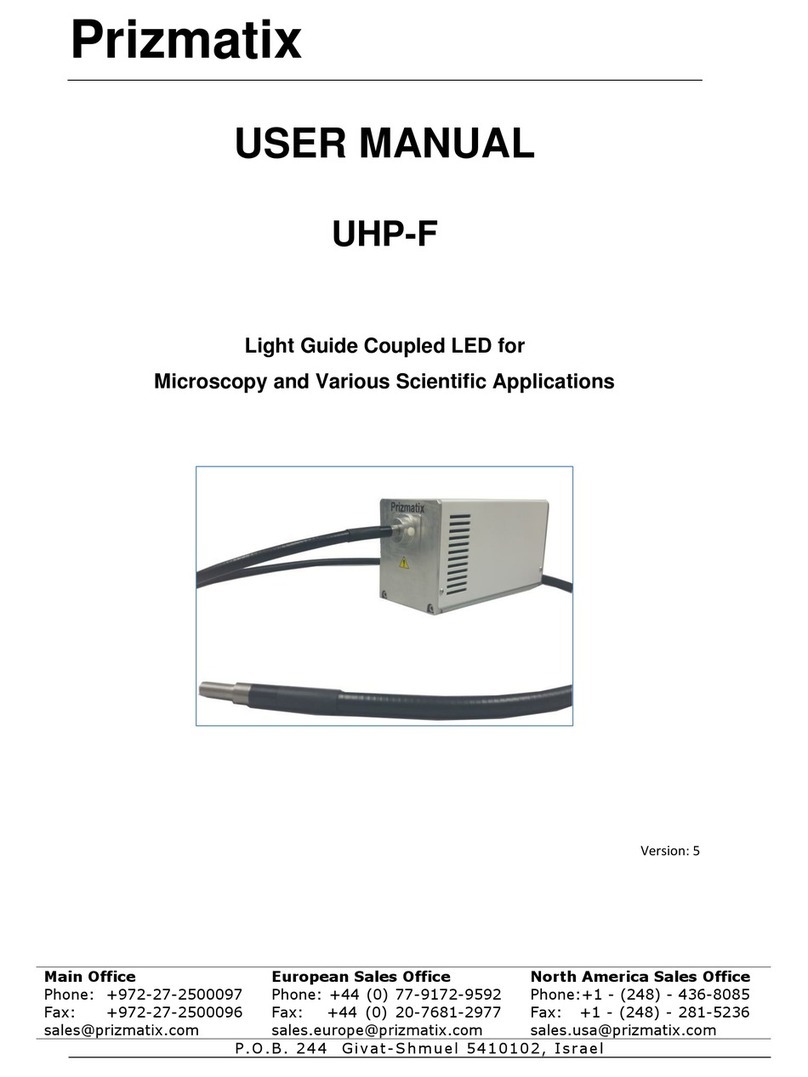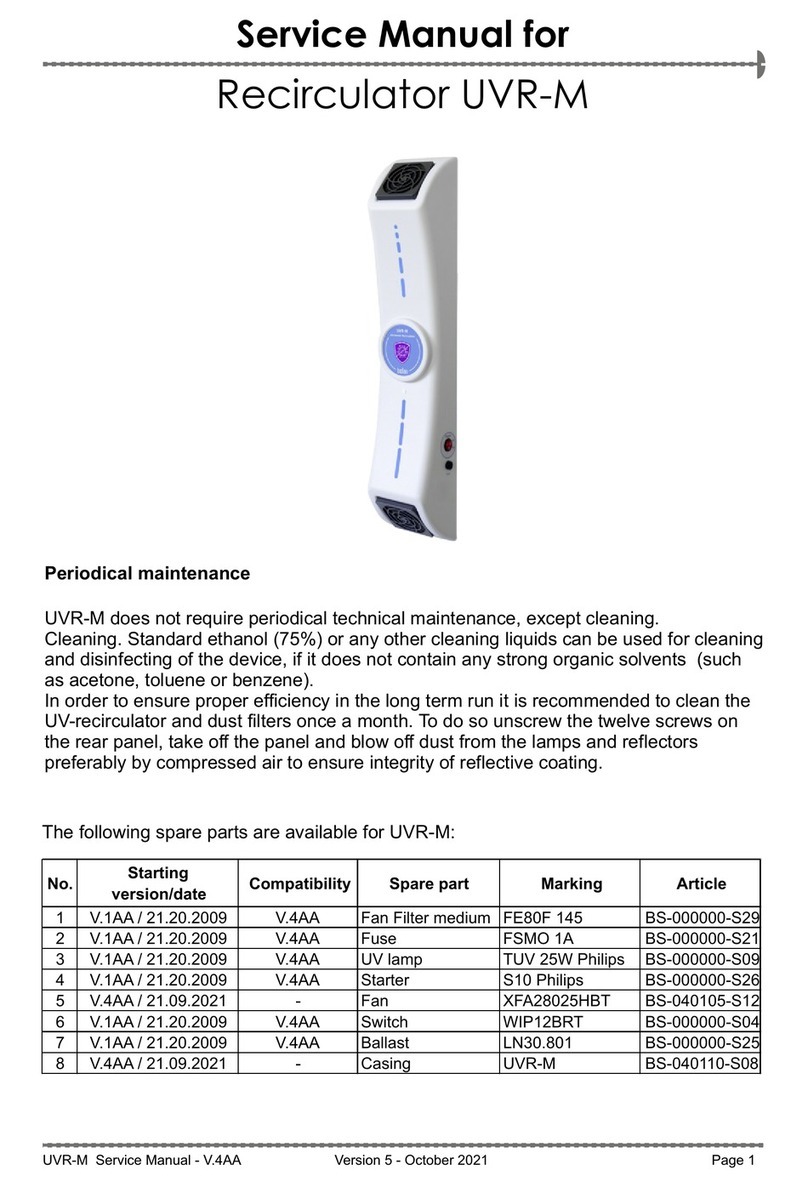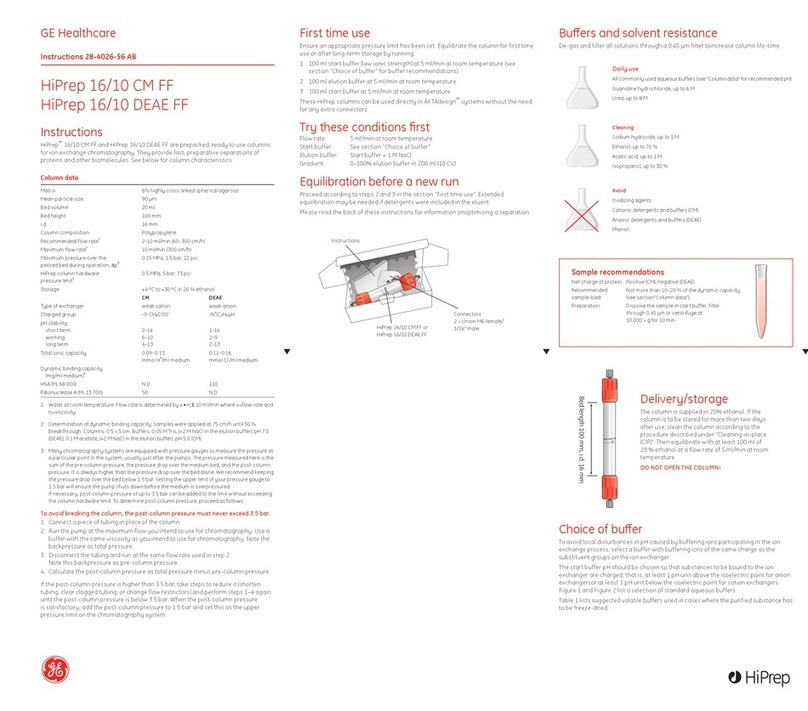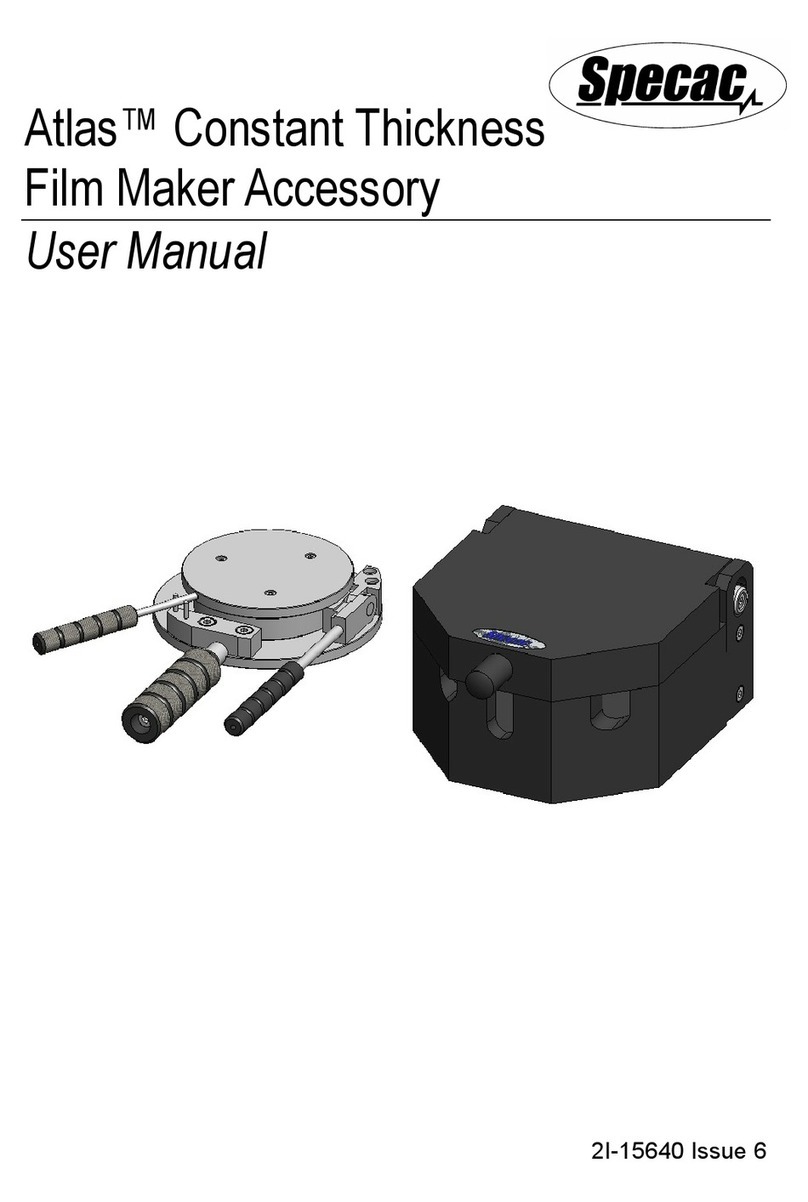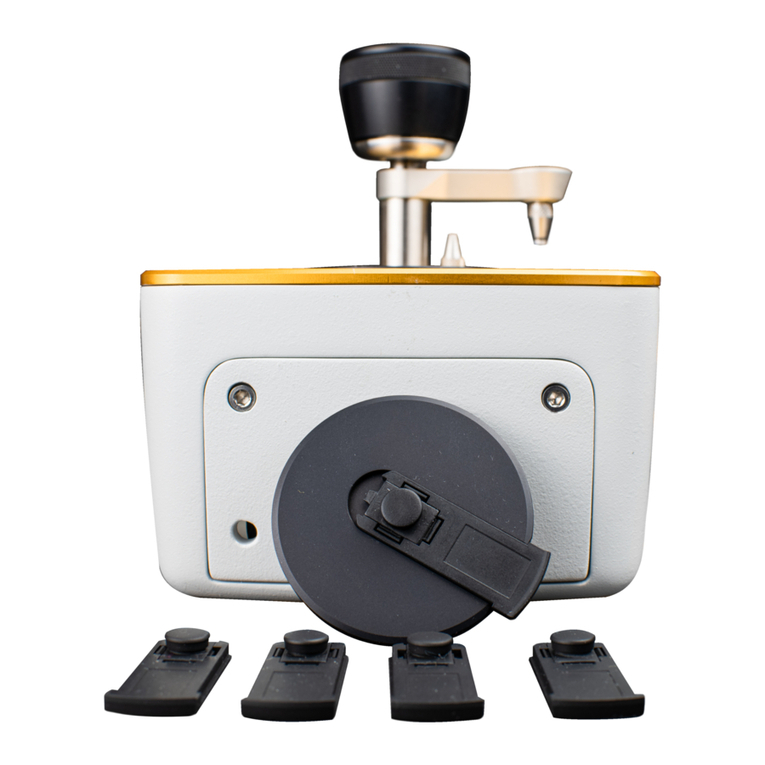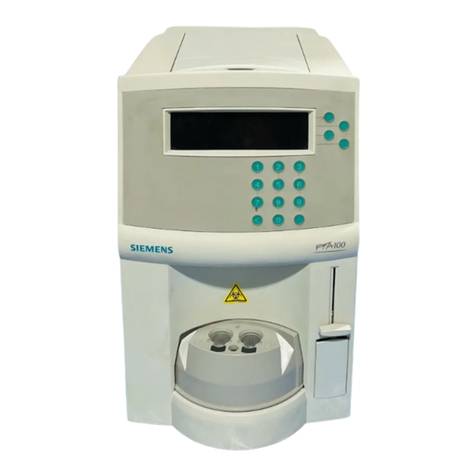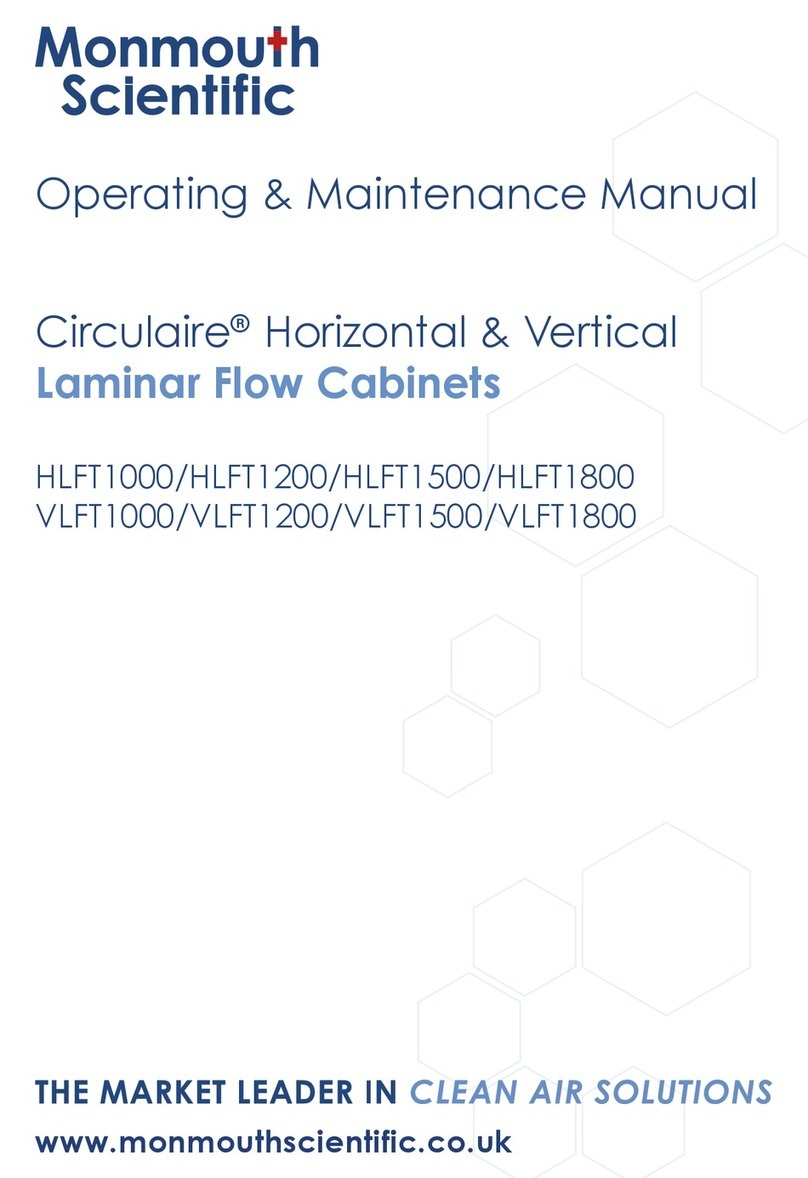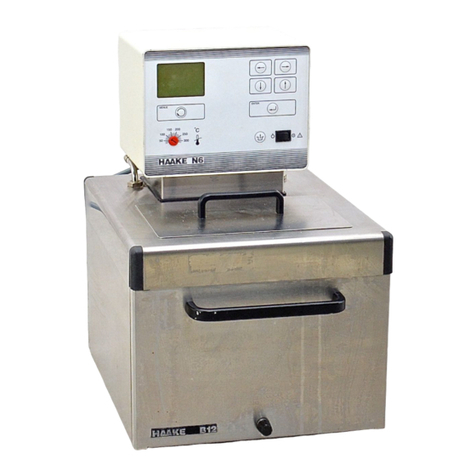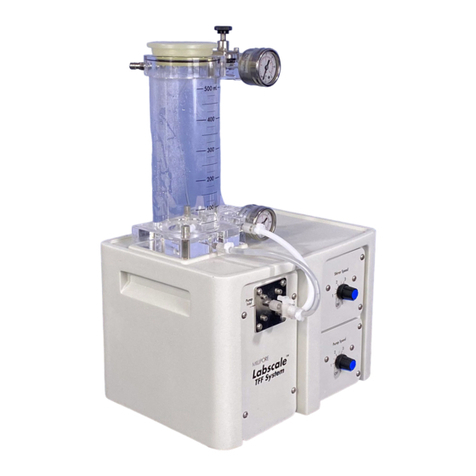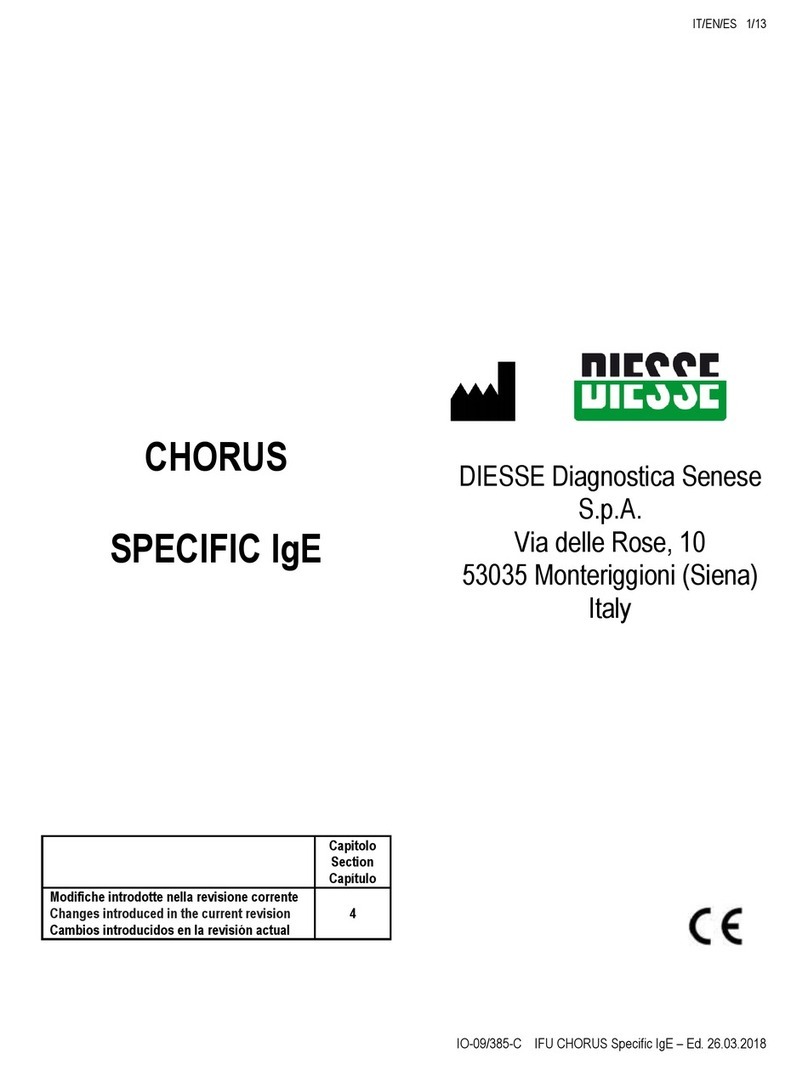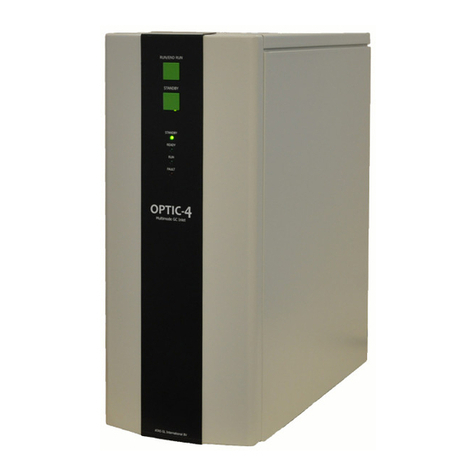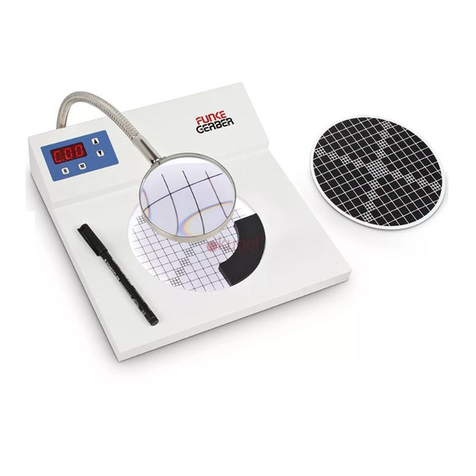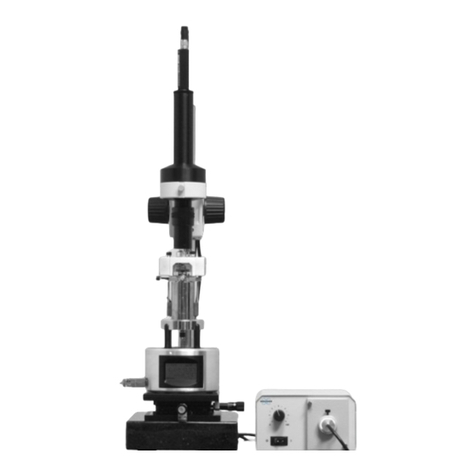helena SAS-3 User manual

1
Operator Manual
English
SAS-3
HL-2-1514P 2017-01(4) [SAS-3 Operators Manual] EN.indd 1 11/01/2017 10:23

SAS-3 Operator Manual
2
HL-2-1514P 2017-01(4) [SAS-3 Operators Manual] EN.indd 2 11/01/2017 10:23

3
Contents
1 The SAS-3 5
1.1 Introduction 5
1.2 Informational symbols 5
1.3 Precautions and Limitations 5
1.4 Safety Considerations 6
2 Installation 7
3 Controls 8
3.1 Mains Supply 8
3.2 Front Panel 8
3.3 Internal 8
4 Operating Instructions 9
4.1 Power up 9
4.2 Program selection 9
4.3 Prepare for electrophoresis 9
4.4 Start an application 9
4.5 Create or Edit a program 10
4.6 View process parameters during program run 11
4.7 Abort a program run 11
5 Options Menu 12
5.1 Language 12
5.2 Test list 12
5.3 Adjust alarm 12
5.4 Key beep 12
5.5 Positive patient ID 12
5.6 Reagent detection 12
5.7 Restore default 12
5.8 LCD contrast 12
5.9 Software version 12
6 Maintenance 13
6.1 Electrophoresis Gel 13
6.2 SAS-3 Carbon Electrode 13
6.3 SAS-3 Reagent Spreader 13
6.4 SAS-3 Antisera Template 13
6.5 SAS-3 60 Sample Tray 13
6.6 Cleaning Spills 13
6.7 Replace fuse(s) 13
6.8 Replacing Contact Sheet 14
6.9 Lubrication of hinges 15
HL-2-1514P 2017-01(4) [SAS-3 Operators Manual] EN.indd 3 11/01/2017 10:23

SAS-3 Operator Manual
4
7 Troubleshooting 16
8 PerformanceSpecication 17
Warranty 18
WEEE 18
HL-2-1514P 2017-01(4) [SAS-3 Operators Manual] EN.indd 4 11/01/2017 10:23

5
1The SAS-3
1.1 Introduction
The SAS-3 is a laboratory instrument designed to perform an electrophoresis
process on Helena Biosciences Europe agarose products. The device
incorporates automated sample application, electrophoresis and automatic
reagent application, spreading and incubation.
This manual provides all necessary information for the setup and operation of
the SAS-3 including important information regarding safety and maintenance
of the unit. To ensure safe and reliable operation, always operate the SAS-3 in
accordance with the operator manual.
READ SECTION 1.3 (PRECAUTIONS AND LIMITATIONS) AND 1.4
(SAFETY CONSIDERATIONS) OF THIS MANUAL BEFORE ATTEMPTING
INSTALLATION AND OPERATION.
Helena Biosciences Europe is not responsible for injuries or damages caused
by improper use.
1.2 Informational Symbols
Warning
The operators manual should be consulted to avoid possible
personal injury or instrument damage.
Caution, high voltage!
Indicates an area where a potential electrical shock hazard may
exist.
CAUTION
CAUTION separate collection of electric and electronic waste at
the end of life, as required by European legislation.
1.3 Precautions and Limitations
To isolate the equipment, remove the plug from the socket. The mains switch
is considered to be the primary disconnect device and should be easily
accessible by the operator.
■The entire operators manual should be read and understood before
attempting instrument operation.
■This instrument is designed for use with Helena Biosciences Europe
products only.
■Refer to the Instructions For Use supplied with the gels and reagents
for correct gel orientation, reagent preparation, specimen collection
and handling, and other information.
HL-2-1514P 2017-01(4) [SAS-3 Operators Manual] EN.indd 5 11/01/2017 10:23

SAS-3 Operator Manual
6
■Always check the parameters set in the SAS-3 program before starting.
TheparametersmaybedierentthanthosedescribedintheInstructions
For Use. The parameters can be accessed via the edit function.
■Do not block air vents and intakes.
■The instrument should not be moved after installation. Before moving,
the instrument’s shipping bracket, used to lock the applicator sled
in place, must be installed. Improper handling of the applicator sled
could result in the instrument requiring re-alignment, which can only be
completed by a representative of Helena Biosciences Europe.
■The SAS-3 must not be used in areas of high electromagnetic
phenomenon as temporary loss of function may occur. Contact Helena
Biosciences Europe for advice.
1.4 Safety Considerations
The SAS-3 is fully overload protected. However, the following guidelines
should be observed to ensure safe operation of the unit.
■The SAS-3 must only be operated when connected to an earthed supply
of the correct voltage and frequency as indicated on the serial number
label.
■For emergency shutdown, use either the ON/OFF (switch on the right
sideofthedevice)orswitchoatthemainssupply.
■Wait at least 5 seconds after stopping a run before handling output leads
or connected apparatus.
■Always make sure your work area is clean and dry before operating the
SAS-3.
■Iftheequipmentisusedinamannernotspeciedbythemanufacturer
the protection provided by the equipment may be impaired.
■To protect the operator against unintentional contact with possible high
voltage between the electrodes a safety precaution has been introduced.
The high voltage will only be applied to the electrodes when the door is
closed. By opening the door the high voltage will end and a warning
signal will be displayed. Act according to the instructions to continue the
process.
To avoid damage to the instrument:
■For proper ventilation, leave at least 10 cm of space behind the
instrument and on either side.
■Do not operate the SAS-3 in high humidity environments (>90%), or
where condensation may occur.
■To avoid condensation, the unit should be left on between use during
operation in a cold room or in high humidity environments.
■Do not lubricate any parts of the instrument.
■Never place objects on top of the instrument.
■Keepammableliquidsandammablevaporsawayfromtheinstrument
at all times.
HL-2-1514P 2017-01(4) [SAS-3 Operators Manual] EN.indd 6 11/01/2017 10:23

7
2 Installation
Please verify upon receiving the SAS-3 that no damage has occurred during
transitandconrmthatthefollowingcomponentsandaccessoriesare
included:
Item No. Units Ref. No.
SAS-3 x 1 1527 (230V)
Operators Manual x 1 HL-2-1514P
Spare Fuses x 2 6003.500
Power cord x 1 7100.001
SAS-3 Carbon Electrode x 2 310400
SAS-3 Reagent Spreader x 2 310505
SAS-3 60 Sample Tray x 1 310900
SAS-3 Gel Block Remover x 1 31110 0
SAS-3 Antisera Template x 1 311000
■Place the SAS-3 unit on a level bench. Keep the area around the
instrument clear to ensure correct ventilation.
■Select an environment free from excessive humidity, dust and large
temperatureuctuations.Allowtheinstrumenttoacclimatisetoroom
temperature for a period of at least 2 hours before operating.
■The power cord attachment module is located at the rear of the unit.
Position the unit so this is easily accessible.
■Remove the shipping bracket that prevents the applicator from moving.
a) Open the lid and locate the shipping bracket on the vertical wall
behind the applicator.
b) Loosen the screw that holds the bracket.
c) Remove the shipping bracket and store in a safe place for
possible re-use should the device require further transportation.
■Connect the unit to a suitable earthed mains outlet of the correct voltage
and frequency. The unit MUST BE EARTHED.
■Turn on the main power switch located on the left side of the instrument.
A green LED will be activated on the service panel when the power is on.
HL-2-1514P 2017-01(4) [SAS-3 Operators Manual] EN.indd 7 11/01/2017 10:23

SAS-3 Operator Manual
8
3Controls
3.1 Mains Supply
ON/OFF Switch This is a rocker-type switch which controls
the mains input to the unit.
3.2 Front Panel
Display Unit: LCD operator interface providing information of
program parameters and machine status.
LED: Indicatesthatthecurrentisowingbetweenthe
electrodes.
Enter: Press to access program parameters.
Press to access and alter individual steps.
Left Arrow: Scroll cursor left.
Right Arrow: Scroll cursor right.
Up Arrow: Scroll by increments through steps.
Increase parameter values.
Down Arrow: Scroll by decrements through steps.
Decrease parameter values.
Start/Stop: Start program / Abort program during run
3.3 Internal
Electrode Posts The electrode posts carry the voltage from the
power supply to the electrodes. The posts are also
magnetic to hold the electrodes in place. The
positive electrode posts are located at the right
hand side of the chamber, the negative at the left.
Reagent Dump Bar The reagent dump bar has three holes, each with a
sensor to detect the presence of the reagent vial,
if required.
Applicator Assembly The applicator assembly holds the required number
of SAS-3 Applicators. It can move left and right to allow
positioning of sample tray and up and down when
loading and applying samples.
Sample Base The sample base locating pins allow the sample tray to
Locating Pins be positioned securely.
HL-2-1514P 2017-01(4) [SAS-3 Operators Manual] EN.indd 8 11/01/2017 10:23

9
4Operating Instructions
4.1 Power up
Connect the unit to an appropriate mains outlet and switch on by using the power
switch located on the left side of the instrument. The display will show the Helena
Biosciences Europe logo. This shows that the machine is ready to operate.:
4.2 Program Selection
Pushing any key will display the list of 12 factory set tests and 5 customer set
tests.
Use the ‘up’ and ‘down’ arrow keys to scroll through the program menu. Press
ENTER to select the required test.
Select the test step with the ‘up’ and ‘down’ arrow keys and press START/STOP
tocommencethetestataspecicstep
4.3 Prepare for electrophoresis
The SAS-3 must be prepared for the required application before the program
commences. Refer to the Instructions For Use supplied with each kit for full
operator instructions.
4.4 Start an application
Before starting the electrophoresis, verify the following. The sample gel is
orientated correctly and the disposable sample cups are installed correctly and
fully seated in the sample tray. The applicator blades are properly seated and
installed in the slots, as indicated in the Instructions For Use supplied with the
reagents. The reagent bottle(s) are installed correctly and fully seated in the dump
bar, if applicable.
From program selection, select the test step with the ‘up’ or ‘down’ arrow keys
andpressSTART/STOPtocommencethetestataspecicstep.
After the program is complete, the instrument will sound, press any key to return
the display to the main menu and remove the gel.
HL-2-1514P 2017-01(4) [SAS-3 Operators Manual] EN.indd 9 11/01/2017 10:23

SAS-3 Operator Manual
10
4.5 Create or Edit a program
Select the required test using the ‘up’ or ‘down’ arrow keys. Press ENTER to show
individual steps, pressing ENTER again opens the Edit Test menu. In the Edit Test
menu all tests can be changed and new test can be created.
The prompt menu provides a selection of messages that the operator should
perform before the instrument will continue the process.
For Example: No prompt
Blot and remove template
Apply sample to template
Remove template, install blotter
Remove gel blocks
Remove excess antisera
Press key to continue
Remove blotter
Install blotter
Remove gel blocks, apply antisera
Wash, Install Blotter
Add Applicators for Serum Samples
The Action menu shows all actions that can be selected in a test:
Load Sample
Theapplicatorisloweredinthesamplecupsforaspeciedtime.
End of test
Pause
Thedevicepausesforaspecictimeenablingtheoperatortoperformtheaction
mentioned at the prompt.
Apply sample
Theapplicatorcontactsthegelforaspeciedtimetherebyapplyingthesample
on the gel.
Electrophoresis
Thegelwillbesubjectedtoahighvoltageduringaspeciedtime.
Apply reagent
When appropriate the gel will be provided with a reagent that is spread with
multiple spreading movements.
HL-2-1514P 2017-01(4) [SAS-3 Operators Manual] EN.indd 10 11/01/2017 10:23

11
Absorb
Thedeviceincubatesthegelunderaspeciedtemperature.
Blot
The device incubates the gel, after a blotter has been placed onto the surface,
underaspeciedtemperature.
Incubate
Thedeviceincubatesthegelunderaspeciedtemperature.
Dry
Thedeviceholdsforaspecictimeunderaspeciedtemperatureandwiththe
internal fan activated.
The Action menu also includes parameters such as: temperature, time, voltage,
speed and cycles.
4.6 View process parameters during a program run
During a program run the process parameters can be viewed on the display.
4.7 Abort a program run
To abort a program at any stage, press START/STOP.
NOTE: It is not possible to pause any stages of the program.
The gel can then be removed.
HL-2-1514P 2017-01(4) [SAS-3 Operators Manual] EN.indd 11 11/01/2017 10:23

SAS-3 Operator Manual
12
5 Options Menu
The SAS-3 is provided with an Options Menu giving access to a number of
instrument settings.
When the display shows Helena Biosciences Europe the Options Menu can
be reached by pushing the ENTER and START/STOP button simultaneously.
Use the ‘up’, ‘down’ and ENTER keys to select the option and choose a new
setting. Pressing START/STOP will save the option.
5.1 Language
Select the display language choosing between English, French, German,
Italian or Spanish. Press ENTER to select, START/STOP to quit.
5.2 Test list
This option shows the full list of tests available for the test menu. Make your
selection with the ‘up’ or ‘down’ keys and changing to + or - with the ‘left’ or
‘right’ keys. Press ENTER to save and stop.
5.3 Adjust alarm
Select your own volume level of the buzzer.
5.4 Key beep
Choose whether to activate a short beep at every key function or to keep the
device silent.
5.5 Positive Patient ID
When a barcode reader is installed at the back of the device it enables the
positive check of the sample tray ID with the gel ID. Only when both ID’s
match the process will start.
5.6 Reagent detection
This option allows for positive detection of the presence of a reagent bottle to
be spread on the gel. When there is no reagent bottle present, the device will
sound an alarm.
5.7 Restore default
This option allows the re-installation of the factory set defaults.
5.8 LCD contrast
The contrast of the display can be set in this option. Watch the contrast
change while activating the arrow keys. Press ENTER to save, START/STOP to
cancel.
5.9 Software version
This option shows the version number of the software, which may be helpful
information when you have questions for your local distributor.
HL-2-1514P 2017-01(4) [SAS-3 Operators Manual] EN.indd 12 11/01/2017 10:23

13
6 Maintenance
This section describes the routine operators procedures. For instrument
calibration or for maintenance not described in this manual contact Helena
Biosciences Europe for assistance.
6.1 Electrophoresis Plate
After each use, dampen a lint-free tissue with deionised water and wash
the surface of the electrophoresis reaction plate. Should an instrument be
contaminatedbybloodorbloodderivatives,turnothepowerandunplugthe
power cord. Spray any contaminated surface with a commercial virucidal and
germicidal agent. Observe where the specimens are used inside the instrument
andconnetothatarea.Wipeuptheresidue.Thesematerialscontainalcohol,
whicharecorrosivetometalsurfaces.Cleanspillsowithasoftclothor
sponge. Do not use corrosive or abrasive cleaners. Dry the unit before plugging
the power cord in.
6.2 SAS-3 Carbon Electrode
After each use, rinse each SAS-3 Carbon Electrode in deionised water and dry
with a lint-free tissue.
6.3 SAS-3 Reagent Spreader
After each use, rinse each SAS-3 Reagent Spreader with deionised water and
dry with a lint-free tissue.
6.4 SAS-3 Antisera Template
After each use, clean the SAS-3 Antisera Template with detergent,
deionised water and a soft brush. Rinse thoroughly with water and dry with
a lint-free tissue.
6.5 SAS-3 60 Sample Tray
If the SAS-3 60 Sample Tray becomes contaminated with blood or blood
derivatives, spray with a commercial virucidal and germicidal agent. Rinse
thoroughly with water and dry with a lint-free tissue.
6.6 Cleaning Spills
CleanspillswithasoftclothorspongeONLYafterturningothepowerand
unplugging the power cord. Do not use corrosive cleansers. Dry the unit before
plugging in the power cord.
6.7 Replace fuse(s)
1. Switchothedeviceandremovethemainscablefromtheinput.
2. Withdraw the fuse carrying tray from the fuse holder and remove the fuses.
3. Replace with fuses of the correct type and rating.
4. Replace fuse holder.
5. Plug power cord back into the instrument and switch on the power.
6. If fuses blow immediately contact Helena Biosciences Europe for assistance.
HL-2-1514P 2017-01(4) [SAS-3 Operators Manual] EN.indd 13 11/01/2017 10:23

SAS-3 Operator Manual
14
6.8 Replacing Contact Sheet
Thecontactsheet,whichinsulatesthereactionplateoor,fatiguesafter
extensive use. Indications are a high voltage error during electrophoresis or a
repeated distortion of the electrophoresis gel in the same area, which can be
related to a physical deformity in the underlying contact sheet. Should either of
these events occur, it is suggested that you replace the contact sheet.
1. Createausertestprogramthatbringsthecopperoortemperature
to approximately 40°C. For instance: Absorb 2 Minutes at 40°C. Run this
program.
2. Whennishedturnothepowerandunplugthecord.
3. Peelotheoldcontactsheetfromthereactionplateoor,startingatthe
right rear corner and pulling slowly to the left. If the contact sheet is
pulled slowly, most of the adhesive will be removed with the old sheet.
4. Thoroughly clean the surface of the reaction plate using mineral spirits
to remove all traces of old adhesive; use a plastic scraper to remove it
easily. Re-apply the mineral spirits as needed. When all the adhesive
has been removed, clean the reaction plate surface with methanol and
gauze to remove all residue left by the mineral spirits. It is very important
thatthereactionplateoorbecompletelyat,smooth,andfreeofany
material. Use a paper towel moistened with methanol to remove any
residuefromthecrevicebetweenthemetalreactionplateoorandthe
reaction plate housing.
5. Ifthereappearstobeanycorrosiononthereactionplateoor,smoothit
usingmetalpolishonasoftcloth.Polishowithadrysoftclothbefore
polish has dried.
6. Once complete, plug in the power cord and turn the main power on.
Re-runtheusertestthatbringsthecopperoorto40°C.
7. Let the unit stand for 5 minutes to evaporate all remaining residue. When
nishedturnothepowerandunplugthecord.
8. Take a new SAS-3 contact sheet. On the side punched with two holes,
peelthebackingoforabout1-2cmandfoldback.Thisstienstheside.
9. Align the new contact sheet, adhesive side down, over the two alignment
pinssothatthetwoholeswilltoverthetworoundpins.Rubtheedge
of the sheet, using gauze squares, so that the exposed adhesive sticks to
thereactionplateoor.
10. Continue peeling the backing from the contact sheet, rubbing the sheet
down as you go on with a side-to-side stroke. Avoid wrinkles and
bubbles; the sheet may be peeled back slightly, taking care not to stretch
it,andsmootheddownagaintocreateaatsurface.Whentheentire
sheetisinplace,itshouldlaycompletelyatandsmooth.
11. Ifthecontactsheethasbeenstretched,itmaybediculttosmoothout
the wrinkles. If this occurs, begin again with a new contact sheet.
12. Once complete, plug in the power cord and turn the main power on.
HL-2-1514P 2017-01(4) [SAS-3 Operators Manual] EN.indd 14 11/01/2017 10:23

15
6.9 Lubrication of hinges
When the lid does not close correctly, or when it needs too much force to
open, it is advised to apply a small drop of oil on each of the hinges.
HL-2-1514P 2017-01(4) [SAS-3 Operators Manual] EN.indd 15 11/01/2017 10:23

SAS-3 Operator Manual
16
7 Troubleshooting
NOTE: If problem persists or any other messages are displayed on the screen,
contact Helena Biosciences Europe for assistance.
Problem Cause Solution
When the main power
is switched on, the
LCD screen remains
blank
Power cord not
connected
Check power cord
connections at both ends
Fuse(s) blown Replace fuse(s)
Poweron/oiso Switchon/oswitch‘on’
The display shows
abnormal characters
and device stops
functioning
Problem may be
causedby excessive
immunityinterference
Try re-starting the device
by switching the power
on/oswitch
The display shows
‘SAFETY SWITCH
DEFECT”
One of the safety
switches is not
working adequately
Contact your local
distributor
Poor electrophoresis
result
Electrophoresis
procedure has not
been performed
correctly
Check program steps
Check electrophoresis
time setting
Check bottle contents
Check port connections
Check electrophoresis
temperature setting
Check and/ or replace
contact sheet
Check and/or replace
electrodes
Contact your local
distributor
Electrophoresis
heating/cooling
problems
Restrictedfanairow
Remove possible
obstructions from the air
inlet
In all other cases Contact your local
distributor
HL-2-1514P 2017-01(4) [SAS-3 Operators Manual] EN.indd 16 11/01/2017 10:23

17
8 PerformanceSpecications
Display: 4 x 20 character LCD
Keypad: 6 keys
Operating Modes: Standby, Program selection, Program editing
and Program run
Input Power: 230 VAC 207-253VAC, 50/60 Hz
Fuses: 2 Fuses 5 x 20; 5A slow
Power: Max. 650 Watt
Safety: Closed door safety switches
Application Speed 1 to 6
speed setting:
Electrophoresis 1-1300 V (minimum step size 5 V)
voltage setting:
Electrophoresis & Set value: from 0 to 99 minutes
incubation Timers: from 0 to 59 seconds
Accuracy: Better than +/- 1 % of setting.
Temperature setting: 10 - 62°C (minimum step size 1°C)
Operating Temperature: 15 - 27°C ambient temperature
Environmental 90% Rh
Conditions:
Dimensions: Weight: 36 kg
Size: 530mm (W) x 270mm (H) x 600mm (D)
HL-2-1514P 2017-01(4) [SAS-3 Operators Manual] EN.indd 17 11/01/2017 10:23

SAS-3 Operator Manual
18
Warranty
Helena warrants each unit to be free from defects in material and
workmanship. Helena’s liability under this warranty is limited to servicing or
adjusting any unit and to replacing any defective part. This warranty is
eectivefor1yearcommencingfromthedateofshipmenttotheoriginal
purchaser, and does not cover faults caused by misuse, abnormal conditions,
damage incurred in shipment, or consumable items such as lamps. This
warranty is made in lieu of all other warranties, expressed or implied, and is
limitedinanysaletotherepairorreplacementoftheaectedcomponent
WEEE
As of the 19th February 2007, Helena Biosciences Europe products meet the
European Union Waste Electrical and Electronic Equipment (WEEE) directive.
Please refer to www.helena-biosciences.com for more information on Helena
Biosciences compliance with the WEEE directive.
When supplied as B2B EEE the producer invokes regulation 12.2 and passes
all WEEE obligations to the end user.
HL-2-1514P 2017-01(4) [SAS-3 Operators Manual] EN.indd 18 11/01/2017 10:23

19
HL-2-1514P 2017-01(4) [SAS-3 Operators Manual] EN.indd 19 11/01/2017 10:23

SAS-3 Operator Manual
20
Helena Biosciences Europe
Queensway South
Team Valley Trading Estate
Gateshead
Tyne and Wear
NE11 0SD
United Kingdom
Tel: +44 (0)191 482 8440
Fax: +44 (0)191 482 8442
Email: info@helena-biosciences.com
HL-2-1514P 2017/01 (4)
HL-2-1514P 2017-01(4) [SAS-3 Operators Manual] EN.indd 20 11/01/2017 10:23
This manual suits for next models
1
Table of contents
Other helena Laboratory Equipment manuals
